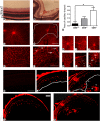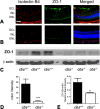Alterations of retinal vasculature in cystathionine-Beta-synthase mutant mice, a model of hyperhomocysteinemia
- PMID: 23307965
- PMCID: PMC3564451
- DOI: 10.1167/iovs.12-10536
Alterations of retinal vasculature in cystathionine-Beta-synthase mutant mice, a model of hyperhomocysteinemia
Abstract
Purpose: Mice with moderate/severe hyperhomocysteinemia due to deficiency or absence of the cbs gene encoding cystathionine-beta-synthase (CBS) have marked retinal disruption, ganglion cell loss, optic nerve mitochondrial dysfunction, and ERG defects; those with mild hyperhomocysteinemia have delayed retinal morphological/functional phenotype. Excess homocysteine is a risk factor for cardiovascular diseases; however, it is not known whether excess homocysteine alters retinal vasculature.
Methods: Cbs(+/+), cbs(+/-), and cbs(-/-) mice (age ∼3 weeks) were subjected to angiography; retinas were harvested for cryosections, flat-mount preparations, or trypsin digestion and subjected to immunofluorescence microscopy to visualize vessels using isolectin-B4, to detect angiogenesis using anti-VEGF and anti-endoglin (anti-CD105) and activated glial cells (anti-glial fibrillary acidic protein [anti-GFAP]) and to investigate the blood-retinal barrier using the tight junction markers zonula occludens-1 (ZO-1) and occludin. Expression of vegf was determined by quantitative RT-PCR (qRT-PCR) and immunoblotting. Human retinal endothelial cells (HRECs) were treated with excess homocysteine to analyze permeability.
Results: Angiography revealed vascular leakage in cbs(-/-) mice; immunohistochemical analysis demonstrated vascular patterns consistent with ischemia; isolectin-B4 labeling revealed a capillary-free zone centrally and new vessels with capillary tufts midperipherally. This was associated with increased vegf mRNA and protein, CD105, and GFAP in cbs(-/-) retinas concomitant with a marked decrease in ZO-1 and occludin. Homocysteine-treated HRECs showed increased permeability.
Conclusions: Severe elevation of homocysteine in cbs(-/-) mutant mice is accompanied by alterations in retinal vasculature (ischemia, neovascularization, and incompetent blood-retinal barrier). The marked disruption of retinal structure and decreased visual function reported in cbs(-/-) mice may reflect vasculopathy as well as neuropathy.
Conflict of interest statement
Disclosure:
Figures







Similar articles
-
Alterations of retinal vasculature in cystathionine-β-synthase heterozygous mice: a model of mild to moderate hyperhomocysteinemia.Am J Pathol. 2014 Sep;184(9):2573-85. doi: 10.1016/j.ajpath.2014.05.018. Epub 2014 Jul 10. Am J Pathol. 2014. PMID: 25016930 Free PMC article.
-
Endogenous elevation of homocysteine induces retinal neuron death in the cystathionine-beta-synthase mutant mouse.Invest Ophthalmol Vis Sci. 2009 Sep;50(9):4460-70. doi: 10.1167/iovs.09-3402. Epub 2009 Apr 8. Invest Ophthalmol Vis Sci. 2009. PMID: 19357353 Free PMC article.
-
Effect of long-term chronic hyperhomocysteinemia on retinal structure and function in the cystathionine-β-synthase mutant mouse.Exp Eye Res. 2022 Jan;214:108894. doi: 10.1016/j.exer.2021.108894. Epub 2021 Dec 11. Exp Eye Res. 2022. PMID: 34906600 Free PMC article.
-
[Hyperhomocysteinemia: an independent risk factor or a simple marker of vascular disease?. 1. Basic data].Pathol Biol (Paris). 2003 Mar;51(2):101-10. doi: 10.1016/s0369-8114(03)00104-4. Pathol Biol (Paris). 2003. PMID: 12801808 Review. French.
-
Murine models of hyperhomocysteinemia and their vascular phenotypes.Arterioscler Thromb Vasc Biol. 2008 Sep;28(9):1596-605. doi: 10.1161/ATVBAHA.108.166421. Epub 2008 Jun 12. Arterioscler Thromb Vasc Biol. 2008. PMID: 18556571 Free PMC article. Review.
Cited by
-
Long-term functional correction of cystathionine β-synthase deficiency in mice by adeno-associated viral gene therapy.J Inherit Metab Dis. 2021 Nov;44(6):1382-1392. doi: 10.1002/jimd.12437. Epub 2021 Oct 11. J Inherit Metab Dis. 2021. PMID: 34528713 Free PMC article.
-
Diabetic Retinopathy and Regulation of Mitochondrial Glutathione-Glutathione Peroxidase Axis in Hyperhomocysteinemia.Antioxidants (Basel). 2024 Feb 20;13(3):254. doi: 10.3390/antiox13030254. Antioxidants (Basel). 2024. PMID: 38539790 Free PMC article.
-
Hydrogen Sulfide Contributes to Retinal Neovascularization in Ischemia-Induced Retinopathy.Invest Ophthalmol Vis Sci. 2016 Jun 1;57(7):3002-9. doi: 10.1167/iovs.15-18555. Invest Ophthalmol Vis Sci. 2016. PMID: 27273718 Free PMC article.
-
Hydrogen sulfide improves postischemic neoangiogenesis in the hind limb of cystathionine-β-synthase mutant mice via PPAR-γ/VEGF axis.Physiol Rep. 2018 Sep;6(17):e13858. doi: 10.14814/phy2.13858. Physiol Rep. 2018. PMID: 30175474 Free PMC article.
-
Epigenetic modifications in hyperhomocysteinemia: potential role in diabetic retinopathy and age-related macular degeneration.Oncotarget. 2018 Jan 29;9(16):12562-12590. doi: 10.18632/oncotarget.24333. eCollection 2018 Feb 27. Oncotarget. 2018. PMID: 29560091 Free PMC article.
References
-
- Perła-Kaján J, Twardowski T, Jakubowski H. Mechanisms of homocysteine toxicity in humans. Amino Acids. 2007; 32: 561–572 - PubMed
-
- Mudd SH. Hypermethioninemias of genetic and non-genetic origin: a review. Am J Med Genet C Semin Med Genet. 2011; 157: 3–32 - PubMed
-
- Bleich S, Jünemann A, Von Ahsen N, et al. Homocysteine and risk of open-angle glaucoma. J Neural Transm. 2002; 109: 1499–1504 - PubMed
-
- Vessani RM, Ritch R, Liebmann JM, Jofe M. Plasma homocysteine is elevated in patients with exfoliation syndrome. Am J Ophthalmol. 2003; 136: 41–46 - PubMed
-
- Jaksic V, Markovic V, Milenkovic S, Stefanovic I, Jakovic N, Knezevic M. MTHFR. C677T homozygous mutation in a patient with pigmentary glaucoma and central retinal vein occlusion. Ophthalmic Res. 2010; 43: 193–196 - PubMed
Publication types
MeSH terms
Substances
Grants and funding
LinkOut - more resources
Full Text Sources
Other Literature Sources
Medical
Molecular Biology Databases
Miscellaneous

